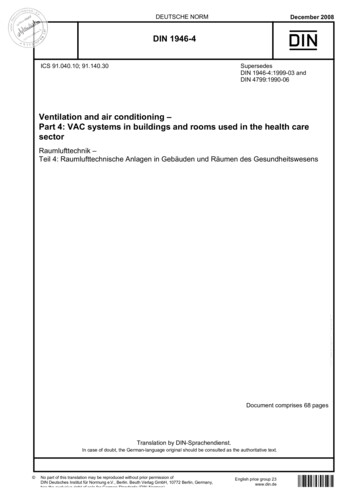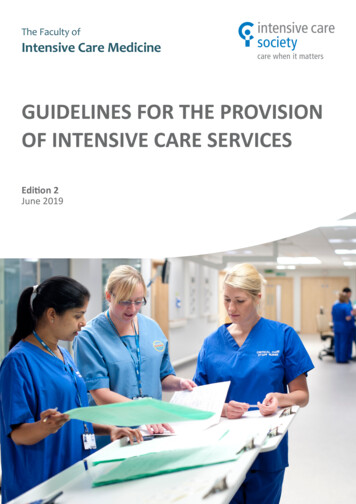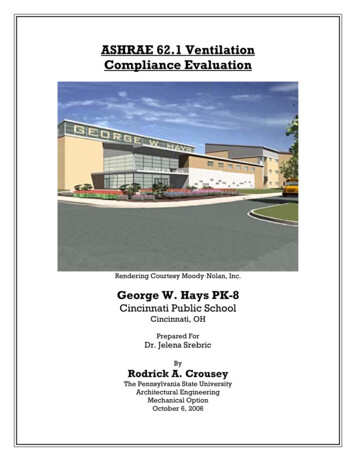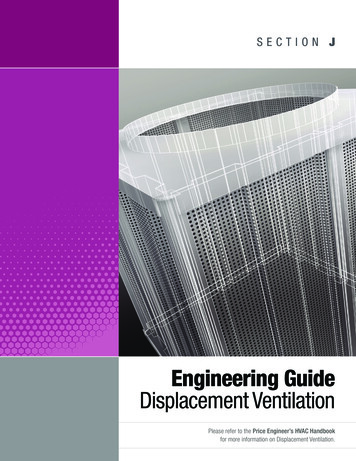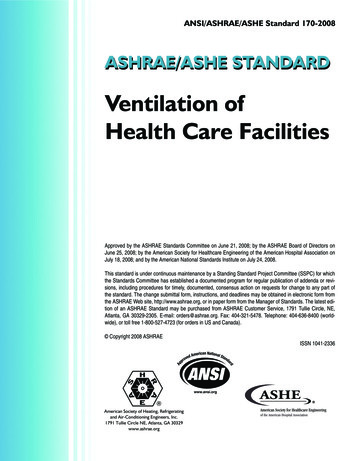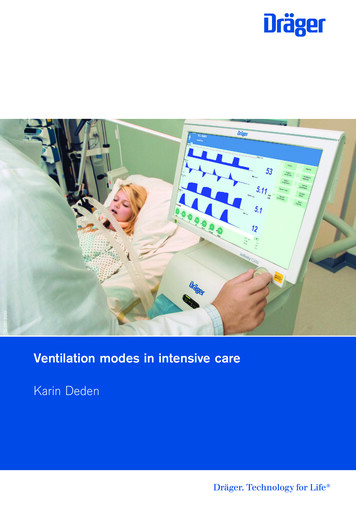
Transcription
D-287-2010Ventilation modes in intensive careKarin Deden
Important noteThis brochure does not replace the instructions for use. Prior to using a ventilator thecorresponding instructions for use must always be read and understood.
Ventilation modes in intensive careKarin Deden
VENTILATION MODES IN INTENSIVE CARE HEADQUARTERSDräger Medical AG & Co. KGMoislinger Allee 53–5523558 Lübeck, Germanywww.draeger.comCONTENTS
04 05CONTENTSImportant notePrefaceIntroductionMechanical ventilationVolume-controlled e-controlled ventilationVolume guaranteePC-CMVPC-ACPC-SIMVPC-SIMV PC-APRVPC-PSVSpontaneous/assisted ventilationSPN-CPAP/PSVariable PSSPN-CPAP/VSSPN-PPSSpecific neonatal ventilation modesSPN-CPAPPC-MMVExtended ventilation settingsNomenclature 32343638404244464850525456586062646668
VENTILATION MODES IN INTENSIVE CARE PREFACEPrefaceTOWARDS A CLASSIFICATION FOR VENTILATIONIn 1977, Steven McPherson wrote the first popular book on ventilationequipment in the USA. Ventilation was discussed on 65 percent of the pages,but only 3 ventilation modes were explained in detail: “controlled”, “assisted”and “spontaneous breathing”. Some modes were not mentioned in thespecification tables for ventilators in the book. Instead, the book focused onspecific drive mechanisms and configurations as well as on how configurationscould be combined into identifiable operating modes. The description ofa ventilator in the book was, for example, akin to an “ electrically drivenrotating piston, double circuit, timed, time and volume limited controller ”. It must be taken into account that the concept of “IMV” (IntermittentMandatory Ventilation) had only been invented four years earlier.The seventh edition of McPherson’s ventilator book was published in 2004.Interestingly, about two thirds of the book are still dedicated to the topic ofventilation. In this edition, only 22 ventilation modes are described on 19 pages.However, on the subsequent pages where specific ventilators are described,93 different ventilation modes are mentioned. These are, however, not 93different modes. In many instances, different names are used for identicalmodes (e.g. the pressure control ventilation plus adaptive pressure ventilationin the Hamilton Galileo corresponds to the pressure regulated volume controlin the Maquet Servo 300), and in some cases, the same name is used fordifferent modes (assist/control in the Puritan Bennett 840 is a kind ofvolume-controlled ventilation, whilst assist/control in the Bear Cubventilator for infants is a kind of pressure-controlled ventilation).As in many other fields, the technical complexity has increased significantlyin ventilation. Today modern ventilators might feature more than two dozenmodes; some even utilize computer-assisted artificial intelligence. Within asingle human generation, ventilators have spanned approximately 5 generations
06 07in development. What has not been developed is a standardized systemsufficiently describing this technical complexity. This causes four mainproblems: (1) published studies about ventilation are difficult to comparemaking it hard to compile and describe factual statements; (2) there is littleconsistency between medical training programs with regard to the nomenclature and descriptions of how ventilators work; (3) clinical staff working inclinics where ventilators of different manufacturers are used (which is quitecommon) do not have the time or training resources for adequate trainingand practice in using all modes in all ventilators, making optimum patientcare difficult and (4) manufacturers cannot discuss the precise operationof their products easily with future customers, limiting the effectiveness ofsales and training and in turn reinforcing the other problems.To date, neither manufacturers nor professional associations have found acommon consensus about a classification for ventilation. However, certainefforts have already been made: The committee TC 121 (Anesthetic andRespiratory Equipment) of the International Organization for Standardizationhas a subcommittee (SC3 Lung Ventilators and Related Equipment) workingon a standardized terminology. "Integrating the Healthcare Enterprise"(IHE) is an initiative of experts and health care companies to improve theexchange of information between computer systems in the health care sector.The IHE domain "Patient Care Device" works on the basis of an RTM profile(Rosetta Terminology Mapping) connecting provider-specific terminologywith standardized terminology (based on ISO/IEEE 11073-10101), predominantly for emergency care equipment such as ventilators. Its aim is the uniformrepresentation of key equipment data, especially if these are communicatedto a gateway for health care applications. The increasing use of electronicpatient files in hospitals worldwide makes the efforts of these organizationsindispensable. Finding a consensus between so many different interestedparties is a long and difficult process. With the compilation of a commonnomenclature for all patient groups in intensive care, anesthesia and duringmonitoring, Dräger Medical makes an important contribution to theseefforts. Dräger Medical recognizes the necessity of practical clarity when
VENTILATION MODES IN INTENSIVE CARE PREFACEdescribing modes. As in other companies, the advanced product designs ofDräger: has its advantages and disadvantages They provide the latest lifesaving technology, but they are also confusingly complex, hampering theexpansion of this technology. The purpose of this booklet is to describe theavailable modes for the Dräger ventilators in a systematic and informativemanner. Although this might not serve as a universal classification for themodes, we hope that it will improve the understanding of the many availableventilation modes for Dräger devices and therefore ultimately improvepatient care.Robert L. Chatburn, BS, RRT-NPS, FAARCClinical Research ManagerRespiratory InstituteCleveland ClinicAdjunct Associate ProfessorDepartment of MedicineLerner College of Medicine of Case Western Reserve UniversityCleveland, Ohio, USA
08 09IntroductionIf you follow a patient from an initial event such as an accident location allthe way until he/she is released from hospital, you will notice that mechanicalventilation is necessary and used in many areas of patient care. Already at theaccident location and during transportation, ventilation is provided using anemergency ventilator. During the operation in the hospital an anesthesiamachine provides ventilation. Intensive care ventilators are available duringthe critical stay in intensive care. Even during the subsequent treatment onintermediate care wards, some patients require mechanical breathing support.Mechanical ventilation is required in all areas of the hospital. For neonatalpatients, the mechanical ventilation starts soon after birth using a ventilatoror manual ventilation bag, usually in the labor room or operating room. Aftera brief transport to the neonatal intensive care ward, these small patientsare ventilated mechanically until their condition is stable. In the variousdepartments with their corresponding patient groups, different ventilationmodes were developed on the basis of the individual needs and requirements.Different names for principally identical modes cause confusion and placeheavy demands on the user. Within international literature, too, differentnames are used for the same ventilation mode. For example, the literatureoften mentions CMV/AC whereas for the ventilation of adults with Drägerequipment the term IPPV/IPPVassist is used. Dräger recognizes how difficultthe current situation is for the user and therefore developed a uniformnomenclature for ventilation modes from emergency provision throughanesthesia and intensive care to monitoring/IT.This brochure intends to facilitate the move from the old to the new nomenclature. For this reason, the properties and control principles of the individualventilation modes are briefly outlined. The focus of the mode descriptionsis the intensive care ventilation for adults, pediatric patients and neonatalpatients. For a precise comparison of the designations, the brochure concludeswith a comparison of the ventilation modes in the previous and the new
VENTILATION MODES IN INTENSIVE CARE INTRODUCTIONnomenclature. The comparison of the designations is given for the intensivecare ventilation of adults and neonatal patients as well as for anesthesia.
10 11Mechanical ventilationWhen operating a ventilator, patients can be ventilated in many differentways. Differentiation is made between mandatory and spontaneous breathingmethods. When utilizing mandatory breathing methods the equipment fullyor partially controls the breathing. During spontaneous breathing methodsthe patient is either fully capable of breathing independently at the PEEPlevel or receive support from the equipment.The ventilation modes of Dräger equipment can be divided into threeventilation groups: volume-controlled modes, pressure-controlled modesand spontaneous/assisted modes.Mandatory ventilation methodsVolume-controlled modesPressure-controlled modesSpontaneous breathing methodSpontaneous/assisted modesTo indicate to which group a ventilation mode belongs, the modes arepreceded by prefixes.– VC- for volume-controlled– PC- for pressure-controlled– SPN- for spontaneousThe prefixes are followed by the name of the ventilation mode which explainsthe ventilation mode and its operation in more detail. This results in thefollowing ventilation modes described in more detail in this brochure:
VENTILATION MODES IN INTENSIVE CARE L -SIMV SPN-CPAP/VSSPN-PPSSPN-CPAPFor some ventilation modes, there are extended configurations, such asAutoFlow (AF), Volume Guarantee (VG) or PS (Pressure Support). Theseextended configurations are explained in more detail in this brochure.In order to understand the particularities of the modes, it is important toknow the control and actuating variables.FORMS OF MANDATORY BREATHThe control variable, primary affected or controlled by the equipment, isidentified by the prefix VC or PC. The control variables are discussed inmore detail in the sections on volume- and pressure-controlled ventilation.When controlling the mandatory ventilation, a difference is made betweenthe control of the start of inspiration and the control of the start of expiration.CONTROL VARIABLE - START OF INSPIRATIONThe inspiration can be initiated by the patient or by the equipment. Thisis called patient-triggered or mechanically triggered mandatory breath.
12 13PawPEEPtFlowTrigger thresholdD-273-2010tFigure 1: Trigger thresholdPATIENT-TRIGGEREDIn patient-triggered mandatory breath, the patient breathes independently.The equipment detects this inspiration attempt and triggers the inspiration.In many ventilators, a flow trigger is used to detect inspiration. The sensitivityof the trigger, the so-called trigger threshold, after which a mandatory breathis applied, can be configured according to the patient (Figure 1). Triggerwindows have been set up for many ventilation modes. Inspiration attemptsof the patient triggering the mandatory breaths are detected only within thisrange. This ensures that the set ventilation frequency of the mandatorybreaths remains constant.MECHANICALLY TRIGGEREDThe mechanically triggered mandatory breaths are triggered without patientactivity. They are always timed. This means that the patient has no influenceon the time of inspiration. The start of inspiration depends exclusively on the
VENTILATION MODES IN INTENSIVE CARE MECHANICAL VENTILATIONPawtStart of inspirationEnd of inspirationFlow100 %D-275-2010x%tFigure 2: Termination criteria (peak inspiration flow)configured time parameters, e.g. the frequency (RR), the inspiration/expiration cycle (I:E ratio) or the inspiratory time (Ti).CONTROL VARIABLE - START OF EXPIRATIONExpiration can be triggered either flow or time cycled.FLOW-CYCLEDWith flow cycling, the start of expiration depends on the breathing and lungmechanics of the patient. The inspiration phase is concluded as soon as theinspiratory flow has reached a defined share of the maximum inspiratoryflow. This means that the patient determins the beginning of the expiratoryphase (Figure 2).
14 15TIME-CYCLEDIf the start of expiration is time-cycled, then only the inspiratory time (Ti)determines the starting point of expiration. The patient has no, or in somemodes only a minor, influence on the duration of the inspiration phase.Control principlesStart of inspirationPatient-triggeredMachine triggeredStart of expirationFlow-cycledTime-cycledWHICH VENTILATION MODE FOR WHICH TREATMENT PHASE?During the ventilation treatment, a patient goes through different phasesmarked by different support requirements (Figure 3).At the start, the patient might be fully sedated. His breathing control is notoperating and he depends on controlled ventilation.If the sedation is subsequently reduced, breathing control may be active to acertain extent, albeit unstable. However, the breathing muscles may be tooweak to cope with the breathing task independently. A mixed ventilation isrequired that permits spontaneous breathing but shares the breathing loadbetween the patient and the equipment.Once the patient has achieved independent and stable breathing, butremains weak, he requires gentle support in breathing. The patient’sbreathing can be supported using spontaneous/assisted ventilation.If the patient has recovered sufficiently to regain his full breathing abilityand his breathing muscles have regained their strength, he can breathespontaneously by himself.
VENTILATION MODES IN INTENSIVE CARE MECHANICAL VENTILATIONSpontaneous breathingControlled ventilationRespiratorymuscleBreathingcontrol systemRespiratorymuscleBreathingcontrol systemsufficientintactintact or paralyzednot availablePatientAssisted spontaneous breathingMixed ventilationBreathingcontrol systemRespiratorymusclesBreathingcontrol systemweakintactweakrestricted orunstableD-274-2010RespiratorymusclesFigure 3: Forms of breathing / ventilationThe symbols with the circles filled in at different levels represent therespective therapy status of the patient. These symbols are provided foreach mode description and assist in determining for which therapy stagethe described mode can be used.ALARM LIMITS:During the treatment of a patient, the overall status can change severaltimes; this also applies to the pulmonary situation of the patient. It cantherefore become necessary to adapt therapeutic objectives or treatmentstrategies.Indicative alarm limits therefore protect the patient and help finding thecorrect time for adapting the ventilation settings.
16 17With every patient admission and every change in ventilation mode,the alarm limits should be checked and adjusted to the patient and theventilation mode.Changes in the lung properties and thus the Resistance (R) and Compliance(C) have different effects in the different ventilation modes.For volume-controlled ventilation modes, the pressures are resulting variables.It is therefore important to adjust the alarm limit Phigh appropriately.In the case of pressure-controlled ventilation modes, the applied tidal volumechanges with a change of Resistance and Compliance. Here, particularattention must be paid to the alarm limits for VThigh, VTlow, MVhigh, MVlowand RRhigh to ensure patient protection.
VENTILATION MODES IN INTENSIVE CARE VOLUME-CONTROLLED VENTILATIONVolume-controlled ventilationDuring volume-controlled ventilation, the set tidal volume is supplied bythe ventilator at a constant flow. The inspiratory pressure is the resultingvariable and changes dependent on the changing lung mechanics.The value controlled and kept at the target value by the equipment is thetidal volume (VT). The tidal volume and the number of mandatory breathsper minute (f) can be adjusted. This results in the minute volume (MV). Thevelocity at which the breathing volume (VT) is applied is adjusted by the flow,the constant inspiratory flow.A breath can be divided into an inspiratory and expiratory phase. The durationof the inspiratory phase is defined by the inspiration time (Ti). If the inspiratory flow is so high that the set breathing volume is reached before the setinspiratory time (Ti) has passed, there will be a pause in inspiration.Because the pressures in the lung can vary in volume-controlled ventilationwith a change in lung properties and thus the Resistance (R) and Compliance (C), it is important to set the alarm limit Phigh based on the patient.To ensure free breathing ability during the complete breathing cycle,and thus increase patient comfort, AutoFlow can be enabled duringvolume-controlled ventilation.Volume-controlled ventilation modes are not available for the neonatalpatient category.
D-255-201018 19215201.7012.05.021FiO2VTTiRRPEEPFlowFigure 4: Possible ventilation settings for volume-controlled ventilation modes for adult patientcategoryDue to the pressure limitation it is possiblethat the set VT is not always achievedMinute volume MV VT * RRAutoFlow can be enabled for all volumecontrolled modesSet the alarm limit Phighpatient-specific Not available in the neonatal patientcategoryVolume-controlled PTiTe1RRFlowD-5-2010Insp. FlowFigure 5: Volume-controlled ventilation
VENTILATION MODES IN INTENSIVE CARE CONTENTSAUTOFLOW– extended ventilation configuration for all volume-controlled ventilationmodes (Figure 6)AutoFlow ensures that the set tidal volume (VT) is applied with the necessaryminimum pressure for all mandatory breaths.If the Resistance (R) or Compliance (C) changes, the pressure adapts graduallyin order to administer the set tidal volume (VT). This means that both thepressure and the flow are adjusted automatically.During the whole breathing cycle, both during inspiration and expiration,the patient can breathe spontaneously.
20 21Decelerating flow curvePressure peaks are preventedFree breathing ability during thebreathing cycleGuaranteed tidal volumePawPinsp f (VT, C)PEEPFlowD-6-2010VTFigure 6: AutoFlow
VENTILATION MODES IN INTENSIVE CARE VOLUME-CONTROLLED VENTILATIONVC-CMV(VOLUME CONTROL - CONTINUOUS MANDATORY VENTILATION)– volume-controlled– time cycled– machine-triggered– constant inspiratory flow (Figure 8)In this volume-controlled ventilation mode, the patient receives the set tidalvolume (VT) with every mandatory breath. The applied breathing volume isindependent of changes in the lung mechanics.The number of mandatory breath is defined by the frequency (RR). Thismeans that the minute volume (MV) remains constant over time.
D-256-201022 23215201.7012.05.021FiO2VTTiRRPEEPFlowFigure 7: Possible ventilation settingsAutoFlow can be enabledSet the alarm limit Phighpatient-specific PawInsp.PausePplatPEEPTi1RRFlowD-5-2010Insp. FlowFigure 8: VC-CMVTe
VENTILATION MODES IN INTENSIVE CARE -VOLUME-CONTROLLED VENTILATIONVC-AC(VOLUME CONTROL - ASSIST CONTROL)– volume-controlled– timed cycled– machine- or patient-triggered– fixed inspiratory flow– backup frequency (Figure 10)In the ventilation mode VC-AC, the patient always receives at least the settidal volume (VT).In VC-AC, every detected inspiration effort of the patient at PEEP leveltriggers an additional mandatory breath. The patient thus determines thenumber of additional mandatory breaths.To give the patient sufficient time for expiration, it is not possible to triggeranother mandatory breath immediately after a completed breath.If after the completion of the expiratory time no mandatory breath has beentriggered, a mandatory breath is automatically applied (backup frequency).The control knob for respiratory rate (RR) therefore defines the minimumventilation frequency.Because the number of mandatory breaths depends both on the patient andthe set frequency (RR), the minute volume (MV) can vary.
D-257-201024 25215201.7012.05.021FiO2VTTiRRPEEPFlowFigure 9: Possible ventilation settingsAutoFlow can be enabledThe trigger sensitivity can be setSet the alarm limit Phighpatient-specific PawInsp.PausePplatPEEPTiD-9-2010FlowFigure 10: VC-ACTe1RRTrigger windowInsp. Flow
VENTILATION MODES IN INTENSIVE CARE -VOLUME-CONTROLLED VENTILATIONVC-SIMV (VOLUME CONTROL - SYNCHRONIZED INTERMITTENTMANDATORY VENTILATION)– volume-controlled– timed cycled– machine- or patient-triggered– fixed inspiratory flow– permitted spontaneous breathing during the expiration phase on PEEPlevel (Figure 12)In VC-SIMV, the patient is supplied with the set tidal volume VT during themandatory breaths.The mandatory breaths are synchronized with the patient's own breathingattempts. To prevent a mandatory breaths from being applied duringspontaneous expiration, a patient-triggered mandatory breath can only betriggered within a trigger window. If the expiration phase and with it thespontaneous breathing time is shortened on account of synchronization,the next expiration phase will be extended. This adaptation prevents achange in the number of mandatory breaths.If no independent breathing attempt is detected during the trigger window,the machine-triggered mandatory breaths are applied. Thus the minutevolume MV remains constant over time.If the breathing attempts of the patient are insufficient to trigger themandatory breath, the machine-triggered mandatory breaths are applied.The patient can breathe spontaneously at PEEP level during the expirationphase. During spontaneous breathing at PEEP level, the patient can bepressure-supported using PS.
D-258-201026 eFlowFigure 11: Possible ventilation settingsAutoFlow can be enabledThe trigger sensitivity can be setSet the alarm limit Phighpatient-specific PawPressure support PSPEEPTiTrigger window1RRFlowD-11-2010Insp. FlowFigure 12: VC-SIMV
VENTILATION MODES IN INTENSIVE CARE -VOLUME-CONTROLLED VENTILATIONVC-MMV(VOLUME CONTROL - MANDATORY MINUTE VOLUME)– volume-controlled– time cycled– machine- or patient-triggered– safeguarding the mandatory minute volume with permitted spontaneousbreathing on PEEP level (Figure 14)VC-MMV guarantees that the patient always receives at least the set minutevolume MV (MV VT*RR).The applied time-cycled, machine-triggered mandatory breaths aresynchronized with the breathing effort of the patient.The patient can always breathe spontaneously at PEEP level. If thespontaneous breathing of the patient is insufficient to achieve the set (MV),machine-triggered time cycled mandatory breaths are applied. Thesemandatory breaths are synchronized with the patient’s own breathingattempts.The set breathing frequency (RR) is therefore the maximum numberof mandatory breaths.During spontaneous breathing at PEEP level, the patient can bepressure-supported using PS.
D-259-201028 peFlowFigure 13: Possible ventilation settingsSet the alarm limit Phighpatient-specific Set the alarm limit RRhighpatient-specific Set the alarm limit Vlowpatient-specific AutoFlow can be enabledThe trigger sensitivity can be setPawPressure support PSPEEPTiTrigger windowFlowD-13-2010Insp. FlowFigure 14: VC-MMV
VENTILATION MODES IN INTENSIVE CARE PRESSURE-CONTROLLED VENTILATIONPressure-controlled ventilationDuring pressure-controlled ventilation, two pressure levels are kept constant:the lower pressure level PEEP and the upper pressure level Pinsp. The volumeand the decelerating flow are the resulting variables and can vary dependenton changes in the lung mechanics (Figure 16).The value controlled and kept at target value by the equipment is the pressuresPinsp. The pressures PEEP, Pinsp and the number of mandatory breaths perminute (RR) can be adjusted. The difference between the two pressure levelsPEEP and Pinsp, the breathing effort of the patient, and the lung mechanicsdetermine the breathing volume (VT) supplied. The minute volume (MV)can vary. With the slope adjustment, the pressure increase can be set to theupper pressure level depending on the patient. During neonatal ventilationthe flow adjustment is frequently used to determine this pressure increase.Both adjustments define the duration of the pressure increase from thelower to the higher pressure level.A breath can be divided into an inspiratory and expiratory phase. The duration of the inspiratory phase is defined by the inspiration time (Ti). Duringpressure-controlled ventilation, the upper pressure level Pinsp is maintainedfor the duration Ti. The time for the next mandatory breath results from thenumber of mandatory breaths per minute (RR) and the inspiratory time (Ti).This time control is not used in PC-PSV.If the lung mechanics of the patient and with it the Resistance (R) andCompliance (C) vary during the ventilation treatment, this only influencesthe applied tidal volume. The pressures remain constant. The pressures arealso maintained in case of leakage.
D-272-201030 e 15: Possible ventilation settings for pressure-controlled ventilation modes for adult patientcategoryAutoFlow can be enabledThe trigger sensitivity can be setSet alarm limit VThighpatient-specific Set the alarm limit Vlowpatient-specific Set the alarm limit RRhighpatient-specific Set alarm limit MVhighpatient-specific Set alarm limit MVlowpatient-specific Pressure controlled modesPC-CMVPC-SIMV owFigure 16: Pressure-controlled ventilation1RR
VENTILATION MODES IN INTENSIVE CARE PRESSURE-CONTROLLED VENTILATIONVOLUME GUARANTEEVolume guarantee is an extended ventilation configuration for pressurecontrolled ventilation modes such as PC-SIMV, PC-AC, PC-CMV and PC-PSV(Figure 17). Volume guarantee ensures that for all mandatory breaths theset tidal volume (VT) is applied with the necessary minimum pressure. Ifthe Resistance (R) or Compliance (C) changes, the pressure adapts graduallyin order to administer the set tidal volume (VT).Spontaneous breathing is possible during the whole breathing cycle.
32 33Decelerating flow curveFree breathing ability during the completebreathing cycleGuaranteed tidal volumePawTest breathPinsp f (VT, C)PEEPFlowD-16-2010VTAbb. 17: Volume guarantee
VENTILATION MODES IN INTENSIVE CARE -PRESSURE-CONTROLLED VENTILATIONPC-CMV(PRESSURE CONTROL - CONTINUOUS MANDATORY VENTILATION)– pressure-controlled– machine-triggered– time cycled– permitted spontaneous breathing during the whole breathing cycle(Figure 19)The tidal volume supplied to the patient depends on the pressure differencebetween PEEP and Pinsp, the lung mechanics and the breathing effort ofthe patient.The number of mandatory breaths is defined by the breathingfrequency (RR).The mandatory breaths are machine-triggered and not triggered bythe patient.
D-260-201034 e 18: Possible ventilation settingsFree breathing ability during thecomplete breathing cycleVolume guarantee can be enabledSet alarm limit VThighpatient-specific Set the alarm limit Vlowpatient-specific Set the alarm limit MVhighpatient-specific Set the alarm limit MVlowpatient-specific PawPinspPEEPTiD-15-2010FlowFigure 19: PC-CMV1RR
VENTILATION MODES IN INTENSIVE CARE -PRESSURE-CONTROLLED VENTILATIONPC-AC(PRESSURE CONTROL - ASSIST CONTROL)– pressure-controlled– time cycled– machine- or patient-triggered– backup frequency– permitted spontaneous breathing during the whole breathing cycle(Figure 21)In PC-AC, every detected breathing attempt at PEEP level triggers a mandatorybreath. The patient thus determines the number of additional mandatorybreaths. In order to give the patient sufficient time for expiration, it is notpossible to trigger another mandatory breath immediately after a completedbreath.If after the completion of the expiratory time no mandatory breath has beentriggered, a mandatory breath is automatically applied (backup frequency).The adjuster for the Respiratory Rate (RR) therefore defines the minimumventilation frequency.The tidal volume (VT) results from the pressure difference between PEEPand Pinsp, the lung mechanics and the breathing effort of the patient.If the Resistance (R) or Compliance (C) of the lung changes during theventilation treatment, the supplied tidal volume (VT) also varies.Because the number of mandatory breaths also depends both on the patientand the set frequency (RR), the minute volume (MV) can vary.
D-261-201036 e 20: Possible ventilation settingsFree breathing ability during the completebreathing cycleThe trigger sensitivity can be setVolume guarantee can be enabledSet alarm limit VThighpatient-specific Set the alarm limit VTlowpatient-specific Set the alarm limit RRhighpatient-specific Set alarm limit MVhighpatient-specific Set alarm limit MVlowpatient-specific PawPinspPEEPTrigger windowTiD-19-2010FlowFigure 21: PC-AC1RR
VENTILATION MODES IN INTENSIVE CARE -PRESSURE-CONTROLLED VENTILATIONPC-SIMV (PRESSURE CONTROL - SYNCHRONIZED INTERMITTENTMANDATORY VENTILATION)– pressure-controlled-– time cycled– machine- or patient-triggered– permitting spontaneous breathing during the whole breathing cycle(Figure 23)In PC-SIMV the patient can breathe spontaneously at any time, but the numberof mandatory breaths is specified.The mandatory breaths are synchronized with the patient’s own breathingattempts. A patient-triggered mandatory breath can only be triggered within atrigger window. If the expiration phase and with it the spontaneous breathingtime is shortened on account of synchronization, the ne
Karin Deden. HEADQUARTERS Dräger Medical AG & Co. KG Moislinger Allee 53-55 23558 Lübeck, Germany www.draeger.com VENTILATION MODES IN INTENSIVE CARE CONTENTS. 04 CONTENTS Important note 02 Preface 06 Introduction 09 Mechanical ventilation 11 Volume-controlled ventilation 18 AutoFlow 20 VC-CMV 22 VC-AC 24 VC-SIMV 26 VC-MMV 28 Pressure-controlled ventilation 30 Volume guarantee 32 PC-CMV .


